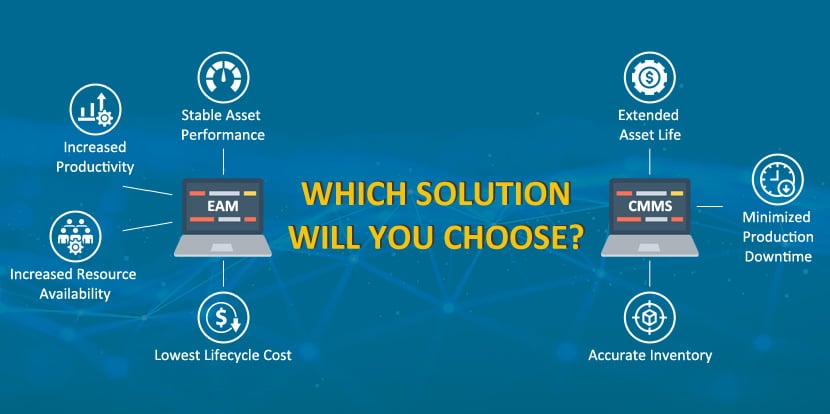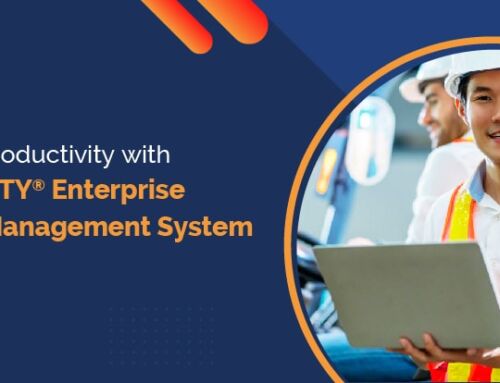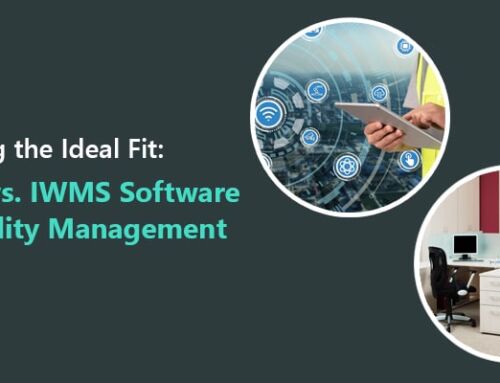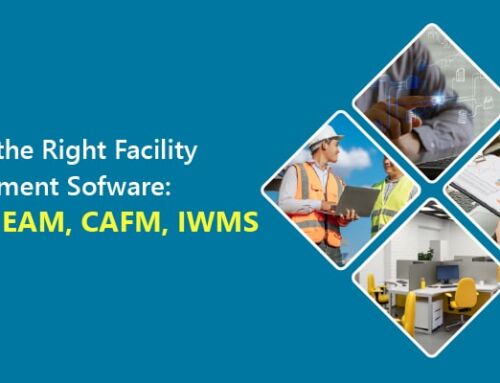As a maintenance head or facilities manager of an enterprise, the top priority would be to reduce equipment breakdowns and increase the lifecycle of all your critical assets. Choosing the ideal software to help you implement the best practices in maintaining the assets easily is imperative to achieving your goals. Since assets are critical to the success of any business, you need to ensure that breakdowns are prevented to increase return on investment.
In your quest for the best asset and maintenance management software, you are most likely to come across the terms EAM and CMMS. Or, if you have already implemented CMMS, you may want to explore what EAM offers.
CMMS is a subset of EAM with overlapping features & functions and is not very different. EAM is a more comprehensive asset management tool that covers much more than preventive and breakdown maintenance.
In today’s scenario, you need a fully automated, future-proof, asset management solution that yields better results. However, choosing a tool that is too much for your team to handle, can result in failed or poor implementations leading to a waste of time, resources, and money.
So, it is of great importance to understand the differences between these tools to make the right choice. This article will guide you in deciding whether to stick with your existing CMMS or upgrade to an Enterprise Asset Management Solution if you are already using one.
It could be that your current maintenance management software does not meet modern requirements, and there could be a limitation to the availability of features, customization limitations, high maintenance costs, etc. If this is so, it is time for you to upgrade to EAM. But if the current CMMS is matching your requirements and requires a few upgrades/modifications, you can upgrade it or look out for a better CMMS software in the market.
First, let’s delve into CMMS and its features and compare them with EAM before we compare one with the other.
What is CMMS?
Computerized maintenance management software- the primary role of CMMS is maintenance and management of the physical assets, hence the term computerized management. CMMS is more about communication and coordination. It aims to provide work order management, labor, and asset management, inventory management, and more. CMMS helps in the optimum utilization of the available resources.
Key features of CMMS
Work Order Management: CMMS automates the work order generation, be it internal or external, reviews status and tracks downtime, personnel assigned on a work, materials used, employee shift time, and more.
Labor and spares/consumables Management: almost everything gets recorded in CMMS, which, in CMMS language, is called asset registry. The availability of materials, their serial number, equipment type, location & position, performance, service management schedules, and more are maintained. It also helps assign specific work to specific employees/workers and schedule their shifts.
Inventory Management: materials availability, usage & statistics, performance, product description, suppliers, spares, and more, and all the details are stored and tracked by CMMS. A key benefit for manufacturers is they automate the stock levels whenever the stock gets decreased to avoid downtime.
What is EAM?
Enterprise asset management covers all types of assets and all of what CMMS covers more comprehensively and offers much more. EAM aims at increasing asset lifecycle, increasing productivity, quality optimization, and reducing operating costs. EAM involves procurement and inventory management, financial management, asset maintenance, workflow management, and asset health & performance management.
EAM helps track, manage, assess, and optimize the quality/reliability of these assets. Asset management helps users better understand, plan, replace, update, and make other necessary changes.
Key features of EAM
Workflow Management: EAM offers its support based on the role of the asset to various sectors in a company, such as the finance team, production team, maintenance team, human resource team, and more. Based on the team and role, EAM offers asset maintenance. You can use it to manage from initial request to completion.
Asset Health and Performance Management: EAM can track the incidents that have occurred in the past to make an analysis and offer reduced risks in the future. It stores all the data regarding past incidents and reduces future risks using incident analysis.
Procurement Management: EAM helps create purchase requisitions, purchase orders, and receipts/returns of goods. It also simplifies Vendor Management with SLA monitoring and management of purchase order amendments, adjustment notes, etc.
Analytics: its enhanced capabilities help in gaining operational insights. It helps in the maximum utilization of the assets present, decreasing downtime, enhancing quality, and reducing operating costs. Its smart compatibility makes everything automated and resolves the issues even before they occur.
Key differences between CMMS vs EAM
| FEATURES & MODULES | CMMS | EAM |
|---|---|---|
| FLEET MANAGEMENT | ✗ | ✓ |
| WORK ORDERS | ✓ | ✓ |
| ENERGY MONITORING | ✗ | ✓ |
| RISK AND WORK PERMITS | ✗ | ✓ |
| KEY MANAGEMENT | ✗ | ✓ |
| PREVENTIVE MAINTENANCE | ✓ | ✓ |
| ASSET PERFORMANCE MANAGEMENT | ✗ | ✓ |
| MANAGEMENT KPIs/DASHBOARDS | ✗ | ✓ |
| ROUTINE/AD-HOC INSPECTIONS | ✗ | ✓ |
| AUDIT MANAGEMENT | ✗ | ✓ |
| RSERVICE LEVEL (SLA) MANAGEMENT | ✗ | ✓ |
| RESOURCE PLANNING | ✗ | ✓ |
| CAPITAL PROJECTS MANAGEMENT | ✗ | ✓ |
How is EAM better than CMMS?
CMMS normally focuses on the assets that have routine maintenance needs, whereas EAM covers all types of assets, and their costs from procurement to maintenance to salvage, performance monitoring and management, etc.
- CMMS is focused on maintenance, while EAM plays on numerous business functions.
- CMMS generally manages assets in a single location, while EAM manages assets across all locations of a business.
- CMMS makes an automated decision, while EAM makes enhanced decisions.
Which one should you choose?
It is not a question of which software system is the best; since CMMS is a subset, the question is “when to go for EAM and when to continue with CMMS?” And the decision is based on the company’s necessity and available resources. It is hard to choose the right asset management software for your business. New products enter the market every year, yet choosing the right software is critical. eFACiLiTY® is such a product that offers CMMS/EAM solutions with a wide range of options to choose from, based on several factors. eFACiLiTY® provides solutions to the most complex problems using its easily accessible and highly developed artificial intelligence for predictive maintenance.
Additionally, eFACiLiTY® also provides comprehensive services in almost every field that businesses require:
ALL UNDER ONE ROOF!

So, no matter what kind of organisation you have, new or old, small or big, call us and get a demo for better understanding.





